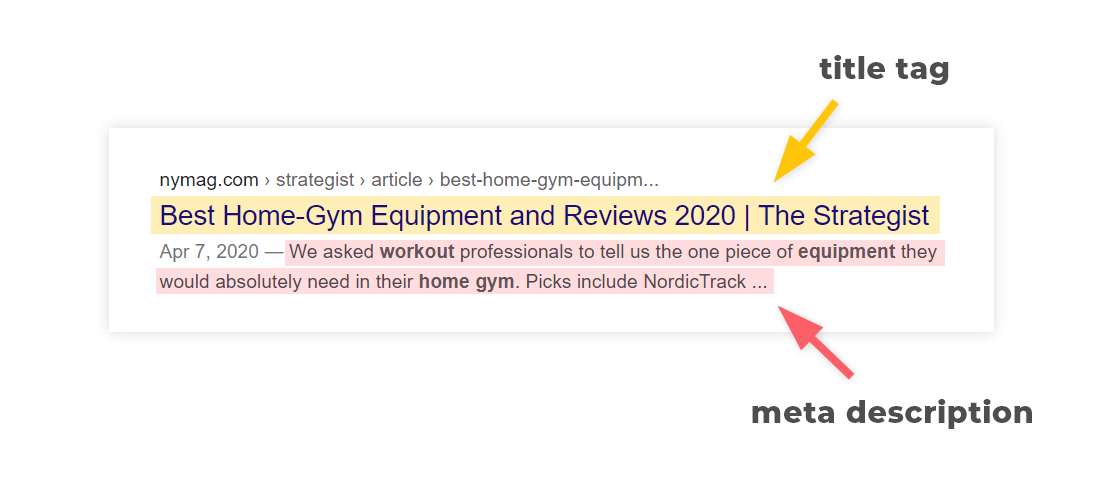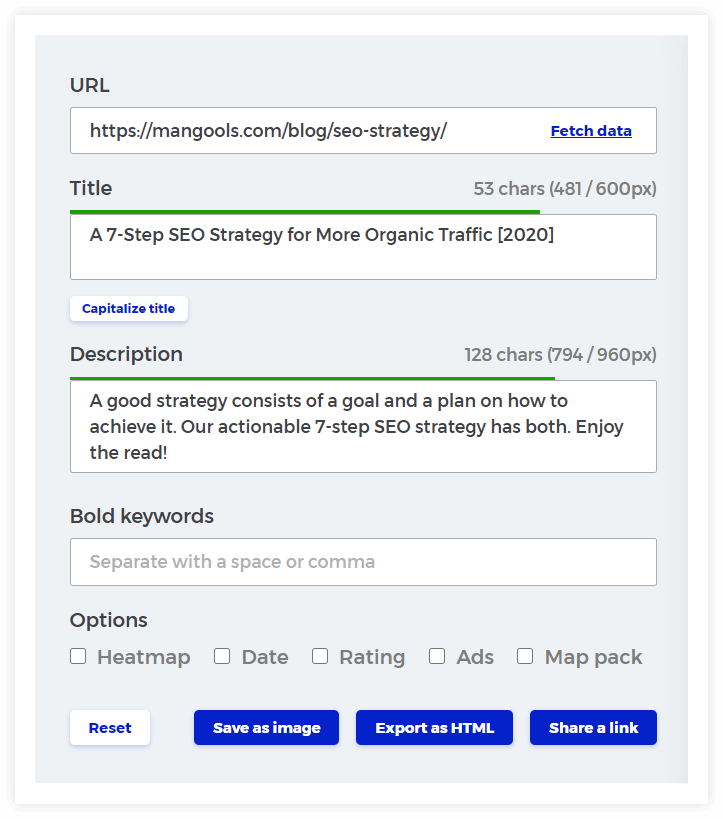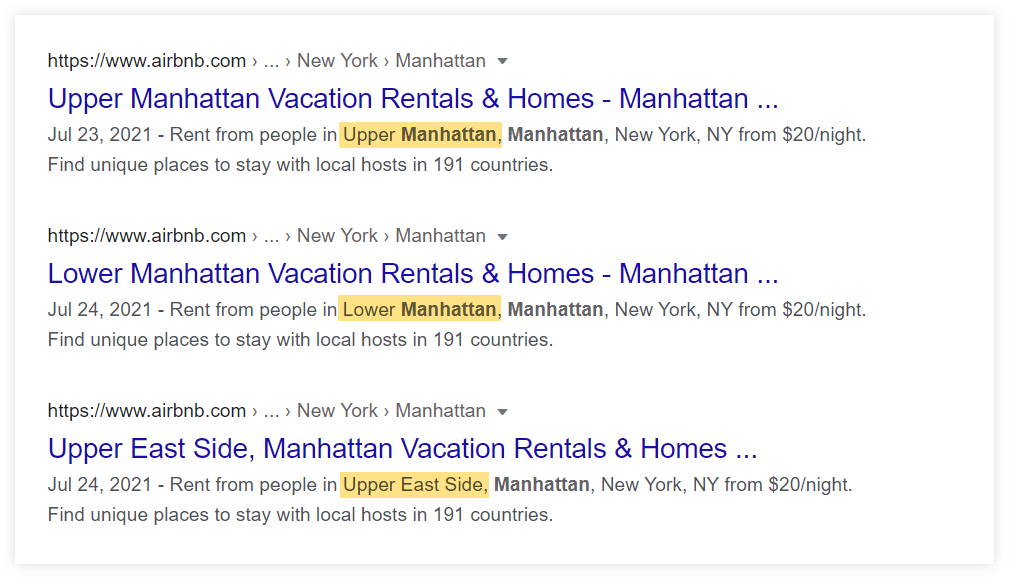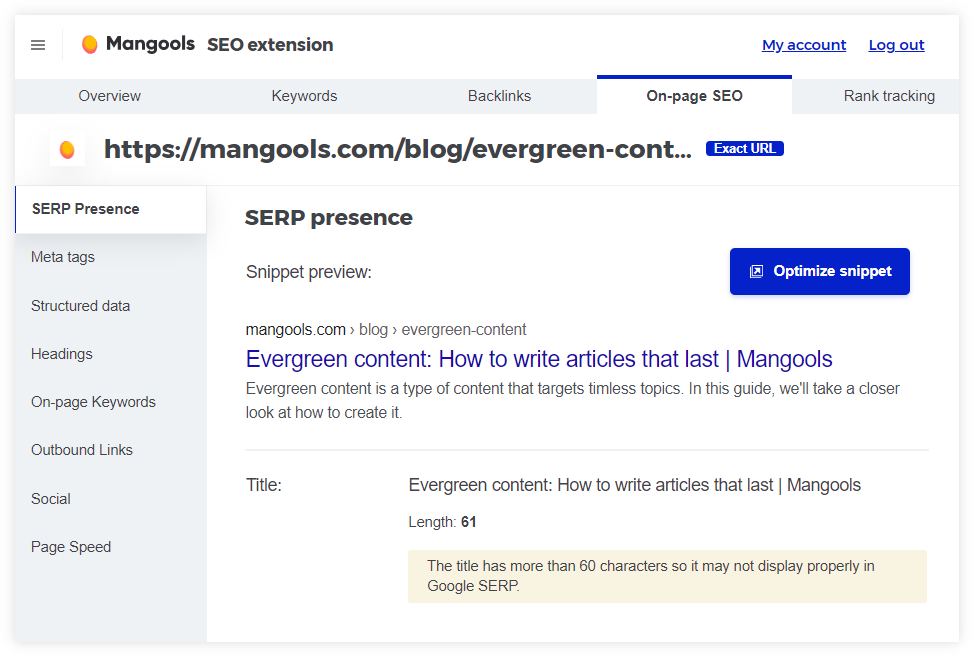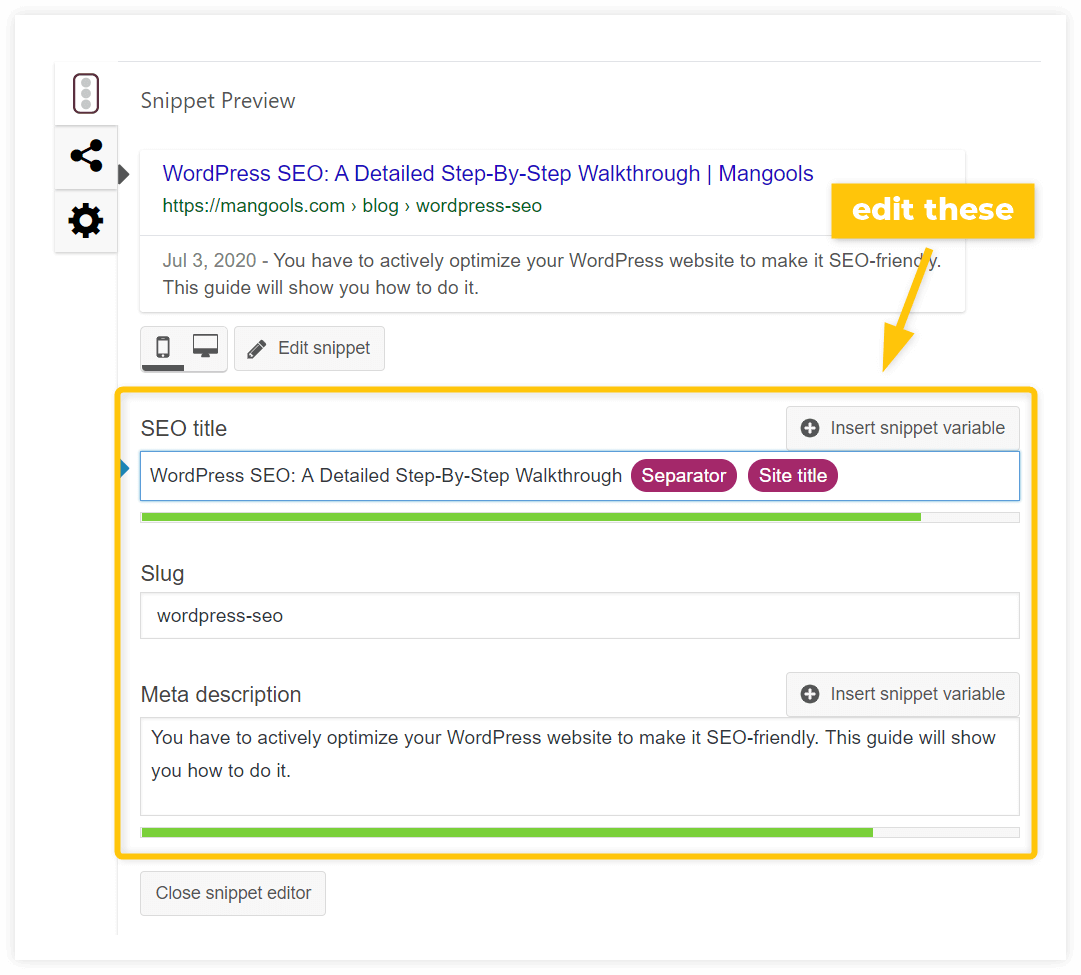What is a meta description?
A meta description is a piece of HTML code that briefly describes what a webpage is about. It usually appears in the SERP as a short text snippet that contains 1 – 3 appealing sentences, right below the title tag.
Here’s an example of what a meta description looks like in the HTML code:
<meta name="description" content="Your awesome meta description!">
And here’s how it looks in the SERP:
Why is meta description important?
Meta description improves the website’s presence in the search results. There are 2 main reasons why every page should have a properly optimized meta description:
- It helps users to understand what your page is about
- It can boost your click-through rate
Let’s take a closer look at the importance of meta descriptions for a website.
1. It helps users
The primary purpose of meta description is to inform users what the webpage is about just in a few words.
Generally speaking, people try to find relevant answers within the SERP as quickly as possible.
With properly written meta descriptions, users can quickly understand the content of the websites within the SERP and choose the ones that might be useful for them.
Although a meta description does not provide any direct SEO benefit, it can help the users to find relevant content easier and therefore improve the initial UX and impression of the page.
2. It boosts CTR
Well-written and appealing meta descriptions can attract more traffic from the result pages and increase the overall CTR (click-through rate) of the website.
Compelling and useful descriptions might convince users to click on the page more often which, as a result, can increase the overall number of visitors, conversion rates, etc.
Tip: Meta descriptions can be used for social media as well!
Social networks (e.g. Facebook or Twitter) use meta descriptions for shared posts, making them more attractive and interesting for the audience.
Since these descriptions are usually shorter, it is recommended to write copies that are specifically designed for social networks and use special metadata (e.g. OpenGraph) to implement them.
Is meta description a ranking signal?
No.
Neither the meta description nor its CTR plays any role in Google’s ranking algorithm. Its only purpose is to improve user experience in the search result pages.
Meta description served as a ranking signal in the past but it changed in 2009 when Google stopped using it for its ranking algorithm due to massive keyword stuffing and spamming abuse.
Even though the meta description can increase the CTR of the page, the metric itself is not a ranking signal either.
John Mueller from Google explained that very clearly:
The description meta tag is generaly used for the snippet that's shown in search. Not everything has to be a ranking factor in order to be useful.
— johnmu is not a chatbot yet 🐀 (@JohnMu) August 24, 2020
How does Google display meta descriptions?
Google can extract snippets of text for the SERP descriptions from 2 sources:
- From the content of the webpage
- From the prepared meta description
Whether Google will choose the first source or the second one (sometimes both) depends on a few factors.
Even with a prepared and well-written meta description, Google might decide to generate its own description from the page. In fact, Google rewrites written meta descriptions in search results over 70% of the time.
Google might generate its own description in 3 cases:
- If the page does not contain a meta description
- If the page has a low-quality meta description
- If meta description does not match the search query
Even well-prepared, high-quality descriptions can be changed by Google to better match relevant search queries.
This usually happens when a piece of content on the page could serve as a better copy for a specific search query rather than the provided meta description.
The ideal length of meta description
It is recommended to keep the length of the text between 120 – 160 characters but the truth is that there is no official rule on how long the meta description should be.
Even Google officially stated that:
“There’s no limit on how long a meta description can be…”
The optimal meta description length may even change over time since Google is constantly trying to improve the appearance of search results.
For example, in 2017, Google temporarily increased the character limit of the meta description up to 300 characters on average but after a few months, it returned to the old standard.
In other words:
We're always working on search, there's not really anything specific to say there. I don't think we ever had a limit on description meta tag content length.
— johnmu is not a chatbot yet 🐀 (@JohnMu) November 28, 2017
Although Google does not have a precise limit on the meta description length, it will trim the text snippet if it’s too long, based on the device type.
Therefore, rather than counting characters, it is recommended to measure the length of meta description in pixels:
- 960 pixels (~130–140 characters) for desktop devices
- 680 pixels (~90–100 characters) for mobile devices
Keep in mind that the real length of your meta description will always be relative and might be changed at any time or not used at all.
Tip: You can test the length and appearance of the meta description in our free SERP Simulator tool and check out how your copy would look like on various result pages.
You can always try and test different versions of your description before publishing your final copy.
How to write a meta description?
For writing a good meta description, you need to understand your audience, niche and have some SEO and marketing thinking. With a little bit of practice, writing proper meta descriptions will be an easy and straightforward process for you.
Let’s take a look at best practices (with examples) that you should keep in mind when writing a meta description.
1. Keep it short and accurate
Your meta description should summarize the content of the page just in a few words.
If it’s too long or too vague, Google will truncate your description to a shorter version or won’t use it at all.
Try to create a very brief yet specific description that would inform users about your page in 1 – 3 sentences. Also, make sure that your copy is not longer than 120 – 160 characters.
Here is an example of what a concise and accurate meta description looks like:
2. Write unique descriptions
Each page should have a unique meta description that would provide value to the users (and search engines).
If you have many pages with identical or similar descriptions, Google will ignore them altogether and generate its own descriptions instead.
Tip: You can use tools such as Screaming Frog SEO Spider or Sitebulb to check whether you use the same meta description across multiple pages on your website
Although it is always recommended to have a unique description for every page, it can become a difficult (if not impossible) task for larger websites (like e-commerce) with thousands of pages.
There are a few ways how to resolve this issue and avoid duplicate meta descriptions on your site:
- Leave the description empty – although it is not the best practice, leaving meta descriptions empty and letting Google generate its own versions is better than using duplicate copies on multiple pages.
- Prioritize important pages – if writing a meta description for every page is not an option, you can just focus on the main pages that bring the most organic traffic to the website.
- Use programmed templates – meta descriptions can be also generated via plugins such as Yoast SEO. All you need to do is to set up variables that will automatically create meta descriptions with changed keywords (or other parameters) only. This is especially useful for commercial websites where it is impossible to write descriptions for thousands of product pages.
Here’s an example of automatically-generated meta descriptions on the Airbnb website:
Keep in mind that automatically generated meta descriptions are not the best substitution for hand-written copies and might be still ignored by the Google algorithm.
3. Create a compelling copy
Write an attractive meta description that will stand out from the others in the SERP.
Creating a copy that would draw the audience to your website is one of the most important (and the most difficult) tasks in the process of writing a meta description.
Fortunately, there are a few actionable steps that you can do to make your copy more appealing:
- Include the focus keyword – primary (and/or secondary) keyword in your meta description will be highlighted in bold if it is matched with the search query. Even though there is no real SEO benefit from that, it will make your copy slightly noticeable and more relevant to the users.
Here’s an example of a highlighted keyword in the description:
- Use active voice – writing in an active voice can make your copy more engaging and interesting. Speaking directly to the users in the meta description might sound like an invitation to your page in comparison to the dull, passive usage of language.
Check out this example:
- Create a call-to-action (CTA) – incorporating action words into the meta description can encourage the users to click on your page. Try to include call-to-action phrases such as “Learn more”, “Check out” or even “Let’s find out” if possible to make your copy more appealing.
Like in our example below:
- Use special characters – symbols, numbers and other special characters can grab the reader’s attention more than ordinary letters.
- For example, you can include prices and numbers for your product descriptions or dashes ( | ) and pipes ( – ) to separate parts of the copy. Sometimes, special symbols and emojis can help make your copy stand out (but there’s a high chance Google won’t show your emojis).
Note: Be careful when implementing special symbols and non-alphanumeric characters in your copy, such as double quotation marks ( “” ), since they can create mistakes and errors within the HTML code of the meta description.
Always make sure that any special characters are properly transcoded to HTML either manually or by using CMS or plugins.
4. Setup structured data
Meta description combined with structured data can significantly improve the presence of your webpage in the search result.
Elements such as breadcrumbs, ratings, pricing or even contact information together with appealing meta descriptions can help you boost the CTR of the snippet and bring more organic traffic to your website.
Structured data are especially useful for reviews, recipe pages, etc. where you can highlight important information right on the result page.
5. Check your competitors
Checking descriptions of other websites in the SERP can help you get some inspiration for creating your own copy.
You can manually check HTML (and meta) tags of every competitive webpage in the SERP or do it faster via various plugins and tools such as Mangools SEO extension to get valuable information such as:
- Actual copy of the meta description
- Number of characters in the description
- Types of structured data
- Preview of the description on social media
How to add a meta description?
If you are using WordPress with plugins such as Yoast SEO, adding meta descriptions to pages is pretty easy:
- Open a new or an existing post in your WordPress editor
- Scroll down to the bottom of the editing page
- In the Yoast SEO section, click on the “Edit Snippet” button and add your copy to the meta description tab.
- Hit the “Update” button
Info: If you would like to know how to add meta description in other popular CMS platforms, check out these guides for:




